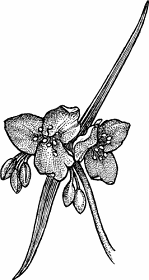: any of a genus (Tradescantia of the family Commelinaceae, the spiderwort family) of American monocotyledonous, usually trailing or creeping plants with narrow leaves and often short-lived white, rose, blue, or violet flowers and that includes some (such as the inch plant) grown as houseplants especially for their ornamental usually striped foliage : tradescantia
Subscribe to America's largest dictionary and get thousands more definitions and advanced search—ad free!
Merriam-Webster unabridged


Share